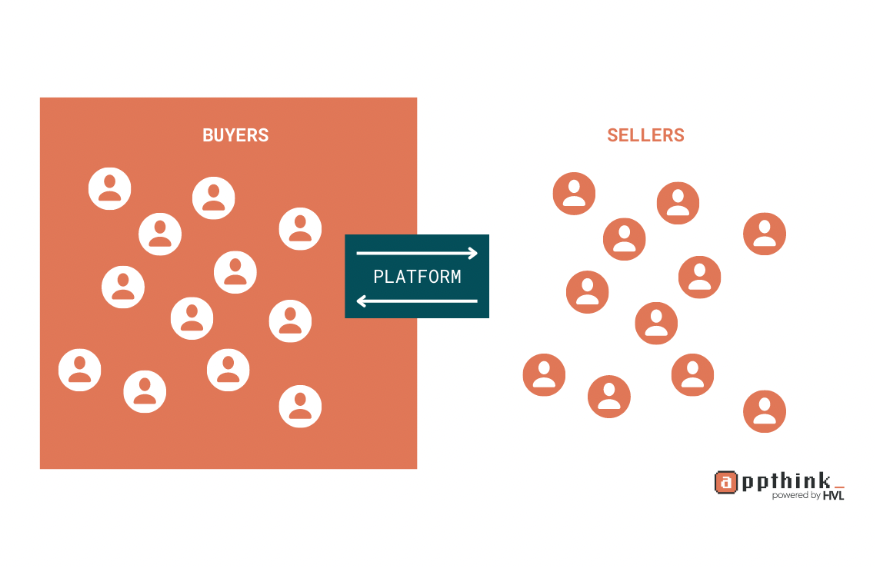Two-Sided Market Place
Technological advancement is rapidly changing how the global economy functions. The credit for this goes to the widespread use of the two-sided marketplace. Companies like Amazon and Uber are just a few examples. What is a two-sided marketplace? Simply put, it is a place for two different groups to communicate via a platform or intermediary. They experience benefits because of that communication.
A two-sided marketplace is a popular business model allowing the direct customer and supplier interaction. The main goal of the intermediary platform is to create value for both the customer and the service provider.
This business model has been among us for quite a while. A historic example of the two-sided marketplace business model is the 1930s invention of the newspaper. This two-sided marketplace has readers paying to read the newspaper, while advertisers pay to promote their products.
We’ll discuss the two-sided marketplace business model, its pros and cons, and provide examples of a few companies that use this model.
What is a Two-Sided Market Place?
The two-sided market is where buyers and sellers find each other to exchange goods or services. The buyer makes a proposal to buy the goods or services, and the seller makes offers (asks) to provide them. When it happens through an intermediary or platform where both parties benefit, that is a two-sided marketplace.
There are other names for this business model, such as “two-sided network” or “two-way market.” Companies in different industries use these two terminologies for a two-sided market. In some instances, the market-makers will simultaneously offer services for both sides of the market.
The two-sided market is a great way to create value by streamlining and accelerating transactions. This brings down the costs for both parties. The two-sided market platform will start to scale up as soon as there is growth on either side.
Users are likely to pay more to access this platform since it offers a larger potential marketplace. The best thing about a two-sided market over a traditional one-sided market is that the customer won’t experience diminishing returns when the market grows.
Though one-sided markets are common in service or manufacturing-oriented businesses, many investors are now migrating to the two-sided market model. A two-sided market is defined by the relationship that exists between the intermediary and other external groups.
Those responsible for overseeing the platform need to keep an equilibrium between both sides to foster a healthy environment. Any change in pricing on one side will automatically affect the other side. This is known as the “waterbed effect.”
Best KPIs for Two-sided Marketplaces
Entrepreneurs need to keep an eye out for critical KPIs to ensure the growth of their businesses. Choosing the right metrics gives the marketplace owner a clear vision of their platform.
LTD (Lifetime to Date)
Lifetime to Date (LTD) tells you how much money a particular customer spent on your platform over a certain period (from the start of their life cycle to a date). You can calculate the LTD using the following formula: LTD = ((AB*n)-С)*t
- AB = average total of money spent
- n = number of orders
- C = cost that platform incurred from acquiring and retaining the customer
- t = time
Month-on-Month Growth
Another critical KPI is Month-on-Month growth. This KPI measures the current month’s growth over the previous month. This helps to identify periodic growth.
GMV (Gross Merchandise Value)
GMV is a fundamental KPI for any online business using the two-sided marketplace business model. It tells you about the dollar value of sales on the platform over time. This is one way to measure a business’s growth and progress.
Examples of Companies That Use the Two-Sided Marketplace Model
Easy access to the internet makes it simple to sustain a two-sided marketplace business model. Most top tech companies use this model to gain a competitive edge over others. Let’s go over a few of them.
Amazon
Amazon is a perfect example of a two-sided marketplace. The brand functions on a C2C (consumer-to-consumer) business model. This allows sellers to advertise their products, and buyers to choose the best one. Amazon doesn’t own any products; it offers a marketplace for buyers and sellers to communicate and interact.
Google is the most common search engine used by consumers and marketers today. Though there are no charges for using the Google search engine, the company collects consumer data to help advertisers. Google then offers the data to both users and marketers while connecting them in the process.
Airbnb
Another example of a two-sided marketplace is Airbnb. Its two parties are people looking for a place to rent and property owners wanting to rent spaces. The brand connects both these groups. Though the brand doesn’t own any rental property, it connects property owners with travelers.
Uber
Uber is another popular example of the two-sided marketplace business model. Like Airbnb, it has two groups’ drivers and riders. Uber doesn’t own any cars. The platform allows drivers to connect with people who need a ride to their destination. It eliminates the need to own or rent a car but allows those that do to earn cash with their vehicle.
In addition to these three, there are many other examples of a two-sided marketplace. Think of companies like Paypal, Netflix, and Facebook.
Benefits of a Two-sided Marketplace for Different Parties
Three parties take part in a two-sided marketplace business model – consumers, advertisers, and the platform itself. Each of them can enjoy different benefits from this business model.
Benefits for Marketplace Buyers
People who head to the marketplace to buy goods and services can enjoy the following benefits.
- A Wide Range of Options: Buyers are offered more choices than in a traditional marketplace.
- Easy and Quick: It is easier for buyers to shop for the best products in a two-sided marketplace. There is far less hassle because all product options are at their fingertips.
- Top-notch Quality Products: The platform creates organic competition. This encourages sellers to deliver the best quality products at an optimal price.
Benefits for Marketplace Sellers
A two-sided marketplace doesn’t only offer customers benefits, but it also does the same for advertisers and sellers.
- New Target Market: The advertising buyers can access new target markets. New markets increase the demand for their product, resulting in more revenue.
- Growth Opportunities: Sellers have access to a larger market, improving their sales volume. The producers/sellers experience growth opportunities such as an increase in brand awareness.
- Hassle-free: Customers gain confidence in a brand because it is on a trusted platform. People purchasing items from Amazon buy them because of the platform’s reputation. Sellers can save time and money on brand recognition because they do not need to build trust from scratch. A new brand can gain instant trust, the platform does it for them.
Benefits of the Marketplace Brand
The platform or the intermediary is a crucial part of the two-sided marketplace. It must ensure that there are no issues between the buyer and seller. Here are some benefits for the marketplace:
- Low or No Operational Costs: The marketplace platform doesn’t produce or own products. No overhead or cost of goods sold equals lower operating costs.
- Networking: As more people use the platform to buy and sell products and services, it creates a stronger network. This allows the platform to grow and increase its user base.
Challenges of the Two-Sided Business Model
Though there are benefits that you can enjoy from a two-sided business model, there are some challenges that you need to be aware of. These challenges can hinder the performance and growth of the platform.
- The Chicken-And-Egg Problem: The platform needs to decide whether to attract customers first or the sellers first. Attracting customers without enough products on your platform would be difficult. Similarly, sellers would only spend their time and money advertising their products if they see a potential target customer base.
- Maintaining the Quality Standards: As an intermediary, the platform must ensure that customers receive high-quality products to maintain its customer base.
- Enhancing the Buyer Experience and Building Trust: The consumers and buyers will only use the platform if they feel that it is trustworthy. You will only book a ride using Uber if you trust it to be safe, affordable, and convenient. Trust is the key to building a strong, customer attraction.
Final Word
The two-sided marketplace business model offers a wide range of benefits to customers, sellers, and entrepreneurs. It allows customers to locate the products and services they need without going through any hassle. Sellers can access new target markets with a large potential consumer base. Following this business model, companies like Amazon, Uber, Airbnb, etc., have opened a world of different avenues for entrepreneurs.
Entrepreneurs can identify a potential customer issue or problem, develop a platform that provides a solution, and enjoy rapid growth in no time.



